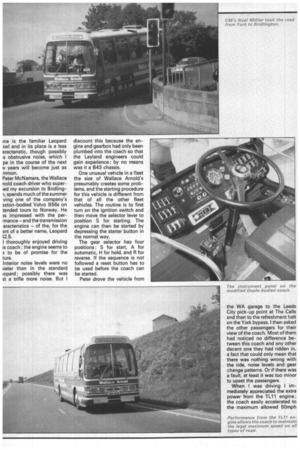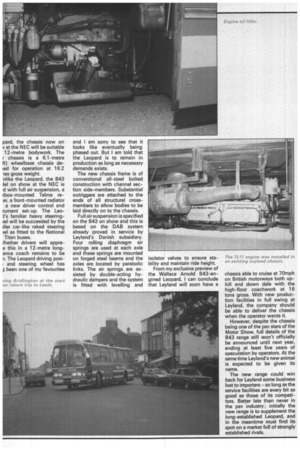Leopard's successo must find its spa
Page 70

Page 71

Page 72

Page 73

If you've noticed an error in this article please click here to report it so we can fix it.
Noel Millier tries a vehicle fitted with th impressive new engine destined for Leyland's long awaited B43 coach; the chassis is on view at the NEC
LEYLAND VEHICLES' longawaited new coach chassis is attracting operators to their show stand at the National Exhibition Centre, Birmingham, but we can't learn all we want about the complete new vehicle.— the B43 — until it is unveiled next year. However, I have been able to stay ahead of the game with an exclusive trial of the new engine, destined for the B43, while installed in a Leyland Leopard.
The 543 range will initially supplement the Leopard. What operators and the industry generally are asking is the same question I am anxious to know the answer to : will the new coach outshine, or even keep up with, its now established foreign competitors? I can only say that the portents are good. It's difficult to guess at this stage whether it will provide the rugged reliability of the Leopard, and only time will tell whether drivers will like it. But one thing is certain. That is that when coach operators finally put the 543 in service Leyland Vehicles will have made every effort and endeavour to ensure that any bugs in the design have been ironed out. So Leyland Vehicles are aiming at reliability, with their reputation gained by the Leopard a strong selling point.
Part of the ironing out process has been to install the TL11 power unit in a Leyland Leopard 12-metre coach in operator service and test it in the hurlyburly of a busy operation.
In July, Leyland engineers visited Wallace Arnold at Leeds and installed the new engine in an S-registration Leyland Leopard coach with Duple Dominant body operating its third season of the long-distance tours and excursions. When I visited Wallace Arnold at Gelderd Road in Leeds in August I was able to take this vehicle for an excursion to Bridlington. The information gained on a trip like this is not as objective as that in a CM road test, but it gave me insight how the B43 will p form in service at the hard er When Leyland engineers stalled the engine they also tc the opportunity to replace original pneumocyclic geart with a Hydracyclic unit fit with fully automatic LVA gear control system and a bu in gearbox retarder.
No decision has been ME to fit this transmission opt' essentially a system for bus to the production vehicle, bu was interesting to see how works when applied to a coa As the gear ratios used are 1 same as with the normal pnc mocyclic semi-automatic cc trolled Leopard system that v apply to the B43 too, pi formance should be broai similar.
The gear ratios on the cic ratio box are 1 : 1, 1.5 : 1, 2.12 and 5.2 :1, reverse is 3.73 :1.
XWX 194S to all intents a purposes appears like any ott particularly well looked afl and comfortably furnished LE land Leopard coach. Once the road, however, differenc became immediately appare
)ne is the familiar Leopard )wl and in its place is a less aracteristic, though possibly s obstrusive noise, which I pe in the course of the next rv years will become just as mmon.
Peter McNamara, the Wallace nold coach driver who superled my excursion to Bridling
spends much of the summer ving one of the company's 5xton-bodied Volvo B58s on tended tours to Norway. He 3s impressed with the per,rnance — and the transmission aracteristics — of the, for the 3nt of a better name, Leopard 12.5.
I thoroughly enjoyed driving is coach ; the engine seems to a to be of promise for the ture.
Interior noise levels were no deter than in the standard iopard ; possibly there was st a trifle more noise. But I discount this because the engine and gearbox had only been plumbed into the coach so that the Leyland engineers could gain experience ; by no means was it a B43 chassis.
One unusual vehicle in a fleet the size of Wallace Arnold's presumably creates some problems, and the starting procedure for this vehicle is different from that of all the other fleet vehicles. The routine is to first turn on the ignition switch and then move the selector lever to position S for starting. The engine can then be started by depressing the starter button in the normal way.
The gear selector has four positions : S for start, A for automatic, H for hold, and R for reverse. If the sequence is not followed a reset button has to be used before the coach can be started.
Peter drove the vehicle from
the WA garage to the Leeds City pick-up point at The Calls and then to the refreshment halt on the York bypass. I then asked the other passengers for their view of the coach. Most of them had noticed no difference between this coach and any other decent one they had ridden in, a fact that could only mean that there was nothing wrong with the ride, noise levels and gear change patterns. Or if there was a fault, at least it was too minor to upset the passengers.
When I was driving I immediately appreciated the extra power from the TL11 engine the coach easily accelerated to the maximum allowed 50mph on the York bypass. The power again was a great boon in enabling a higher average speed than would have been possible with a standard Leopard on the undulating country roads to Bridlington.
Putting the selector lever in the A position made driving easy, the gears changed both up and down the box when relevant road speed was attained. A kick-down facility allowed an extra 5mph in each gear and gave the power needed for overtaking farm tractors and climbing the shorter inclines encountered on the route. Using the kick-down from a standing start enabled first gear to be selected as the coach normally started in second.
Each gear could also be held by using the H position on the selector. By shifting the lever briefly into neutral it was possible to drive as with a semiautomatic transmission.
The coach was also fitted with a built-in gearbox retarder as used on Leyland's Titan double-decker bus. Unlike the normal bus application where the retarder is controlled by initial pressure on the brake pedal, a Telma hand-control lever is used. Wallace Arnold prefers this as it always allows reserve braking should the brake pedal be fouled by an obstruction such as a rolling coke can. The gearbox retarder performance was not as noticeable as an electric type, but it did slow the coach sufficiently for the automatic change-down to come into operation.
To drive the coach with its familiar Leopard driving position and with the gear selector in the position of the normal pneumocyclic control seemed strange. However, the performance did illustrate that what was developed to aid drivers of urban buses, also works when applied to a coach. Whether it has any benefit in terms of reduced driver fatigue or improved fuel consumption is debatable. The Hydracyclic transmission is not expected to be an initial B43 option.
I am sure that the new vehicle will excel at hill climbing by the way we climbed the 1 in Garrowby Hill. Impressive, tc was its performance in a celerating to 30mph in abo 12 seconds and to 50 in und 25 seconds in ordinary servi conditions. One problem I d encounter was caused by ti gears being set to change frc fourth to fifth at 35mph. TF meant that in town the vehic would be changing up ar down rather too often at urban cruising speed.
The new Leyland coach expected to enter productic early next year. The TL11 engir as fitted to the Wallace Arno vehicle will be standard and a horizontally mounted direc injection turbocharged unit di veloping 162kW (218bhp) 2000rpm. Maximum torque fro the unit, which has already beE proven in Leyland's lorry rang is 857Nm (630 lb/ft) 130Orpm.
The Wallace Arnold coac was fitted with a close-rat ,gearbox, but the first B43 w have a five-speed wide rat pneumocyclic box with sem automatic control. Like the W pard, the chassis now on v at the NEC will be suitable 12-metre bodywork. The chassis is a 6.1-metre It) wheelbase chassis deied for operation at 16.2 les gross weight.
nlike the Leopard, the 843 lel on show at the NEC is d with full air suspension, a rbox-mounted Telma reer, a front-mounted radiator a new driver control and rument set-up. The Leoi's familiar heavy steering3e1 will be succeeded by the iller car-like raked steering el as fitted to the National Titan buses.
/hether drivers will appre e this in a 12-metre longance coach remains to be 1. The Leopard driving posi
and steering wheel has 4 been one of my favourites
and I am sorry to see that it looks like eventually being phased out. But I am told that the Leopard is to remain in production as long as necessary demands exists.
The new chassis frame is of conventional all-steel bolted construction with channel section side-members. Substantial outriggers are attached to the ends of all structural crossmembers to allow bodies to be laid directly on to the chassis.
Full air suspension is specified on the B43 on show and this is based on the DAB system already proved in service by Leyland's Danish subsidiary. Four rolling diaphragm air springs are used at each axle and these springs are mounted on forged steel beams and the axles are located by parabolic links. The air springs are assisted by double-acting hydraulic dampers and the system is fitted with levelling and
-solator valves to ensure stability and maintain ride height.
From my exclusive preview of the Wallace Arnold B43-engined Leopard, I can conclude that Leyland will soon have a chassis able to cruise at 70mph on British motorways both uphill and down dale with the high-floor coachwork at 16 tons gross. With new production facilities in full swing at Leyland, the company should be able to deliver the chassis when the operator wants it.
However, despite the chassis being one of the psv stars of the Motor Show, full details of the B43 range still won't officially be announced until next year, ending at least five years of speculation by operators. At the same time Leyland's new animal is expected to be given its name.
The new range could win back for Leyland some business lost to importers—so long as the service facilities are every bit as good as those of its competitors. Better late than never in the psv industry; initially the new range is to supplement the long-established Leopard, and in the meantime must find its spot on a market full of strongly established rivals.




























































































































































































































































































